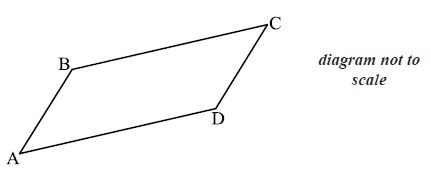| Date | November 2008 | Marks available | 7 | Reference code | 08N.2.sl.TZ0.8 |
| Level | SL only | Paper | 2 | Time zone | TZ0 |
| Command term | Find and Hence | Question number | 8 | Adapted from | N/A |
Question
The diagram shows a parallelogram ABCD.

The coordinates of A, B and D are A(1, 2, 3) , B(6, 4,4 ) and D(2, 5, 5) .
(i) Show that \(\overrightarrow {{\rm{AB}}} = \left( {\begin{array}{*{20}{c}}
5\\
2\\
1
\end{array}} \right)\) .
(ii) Find \(\overrightarrow {{\rm{AD}}} \) .
(iii) Hence show that \(\overrightarrow {{\rm{AC}}} = \left( {\begin{array}{*{20}{c}}
6\\
5\\
3
\end{array}} \right)\) .
Find the coordinates of point C.
(i) Find \(\overrightarrow {{\rm{AB}}} \bullet \overrightarrow {{\rm{AD}}} \).
(ii) Hence find angle A.
Hence, or otherwise, find the area of the parallelogram.
Markscheme
(i) evidence of approach M1
e.g. \({\text{B}} - {\text{A}}\) , \(\overrightarrow {{\rm{AO}}} + \overrightarrow {{\rm{OB}}} \) , \(\left( {\begin{array}{*{20}{c}}
6\\
4\\
4
\end{array}} \right) - \left( {\begin{array}{*{20}{c}}
1\\
2\\
3
\end{array}} \right)\)
\(\overrightarrow {{\rm{AB}}} = \left( {\begin{array}{*{20}{c}}
5\\
2\\
1
\end{array}} \right)\) AG N0
(ii) evidence of approach (M1)
e.g. \({\text{D}} - {\text{A}}\) , \(\overrightarrow {{\rm{AO}}} + \overrightarrow {{\rm{OD}}} \) , \(\left( {\begin{array}{*{20}{c}}
2\\
5\\
5
\end{array}} \right) - \left( {\begin{array}{*{20}{c}}
1\\
2\\
3
\end{array}} \right)\)
\(\overrightarrow {{\rm{AD}}}= \left( {\begin{array}{*{20}{c}}
1\\
3\\
2
\end{array}} \right)\) A1 N2
(iii) evidence of approach (M1)
e.g. \(\overrightarrow {{\rm{AC}}} = \overrightarrow {{\rm{AB}}} + \overrightarrow {{\rm{AD}}} \)
correct substitution A1
e.g. \(\overrightarrow {{\rm{AC}}} = \left( {\begin{array}{*{20}{c}}
5\\
2\\
1
\end{array}} \right) + \left( {\begin{array}{*{20}{c}}
1\\
3\\
2
\end{array}} \right)\)
\(\overrightarrow {{\rm{AC}}} = \left( {\begin{array}{*{20}{c}}
6\\
5\\
3
\end{array}} \right)\) AG N0
[5 marks]
evidence of combining vectors (there are at least 5 ways) (M1)
e.g. \(\overrightarrow {{\rm{OC}}} = \overrightarrow {{\rm{OA}}} + \overrightarrow {{\rm{AC}}} \) , \(\overrightarrow {{\rm{OC}}} = \overrightarrow {{\rm{OB}}} + \overrightarrow {{\rm{AD}}} \), \(\overrightarrow {{\rm{AB}}} = \overrightarrow {{\rm{OC}}} - \overrightarrow {{\rm{OD}}} \)
correct substitution A1
\(\overrightarrow {{\rm{OC}}} = \left( {\begin{array}{*{20}{c}}
1\\
2\\
3
\end{array}} \right) + \left( {\begin{array}{*{20}{c}}
6\\
5\\
3
\end{array}} \right)\left( { = \left( {\begin{array}{*{20}{c}}
7\\
7\\
6
\end{array}} \right)} \right)\)
e.g. coordinates of C are \((7{\text{, }}7{\text{, }}6)\) A1 N1
[3 marks]
(i) evidence of using scalar product on \(\overrightarrow {{\rm{AB}}} \) and \(\overrightarrow {{\rm{AD}}} \) (M1)
e.g. \(\overrightarrow {{\rm{AB}}} \bullet \overrightarrow {{\rm{AD}}} = 5(1) + 2(3) + 1(2)\)
\(\overrightarrow {{\rm{AB}}} \bullet \overrightarrow {{\rm{AD}}} = 13\) A1 N2
(ii) \(\left| {\overrightarrow {{\rm{AB}}} } \right| = 5.477 \ldots \) , \(\left| {\overrightarrow {{\rm{AD}}} } \right| = 3.741 \ldots \) (A1)(A1)
evidence of using \(\cos A = \frac{{\overrightarrow {{\rm{AB}}} \bullet \overrightarrow {{\rm{AD}}} }}{{\left| {\overrightarrow {{\rm{AB}}} } \right|\left| {\overrightarrow {{\rm{AD}}} } \right|}}\) (M1)
correct substitution A1
e.g. \(\cos A = \frac{{13}}{{20.493}}\)
\(\widehat A = 0.884\) \((50.6^\circ )\) A1 N3
[7 marks]
METHOD 1
evidence of using \({\rm{area}} = 2\left( {\frac{1}{2}\left| {\overrightarrow {{\rm{AD}}} } \right|\left| {\overrightarrow {{\rm{AB}}} } \right|\sin {\rm{D}}\widehat {\rm{A}}{\rm{B}}} \right)\) (M1)
correct substitution A1
e.g. \({\rm{area}} = 2\left( {\frac{1}{2}(3,741 \ldots )(5.477 \ldots )\sin 0.883 \ldots } \right)\)
\({\rm{area}} = 15.8\) A1 N2
METHOD 2
evidence of using \({\rm{area}} = b \times h\) (M1)
finding height of parallelogram A1
e.g. \(h = 3.741 \ldots \times \sin 0.883 \ldots ( = 2.892 \ldots )\) , \(h = 5.477 \ldots \times \sin 0.883 \ldots ( = 4.234 \ldots )\)
\({\rm{area}} = 15.8\) A1 N2
[3 marks]
Examiners report
Candidates performed very well in this question, showing a strong ability to work with the algebra and geometry of vectors.
Candidates performed very well in this question, showing a strong ability to work with the algebra and geometry of vectors.
Some candidates were unable to find the scalar product in part (c), yet still managed to find the correct angle, able to use the formula in the information booklet without knowing that the scalar product is a part of that formula.
Few candidates considered that the area of the parallelogram is twice the area of a triangle, which is conveniently found using \({\rm{B}}\widehat {\rm{A}}{\rm{D}}\) . In an effort to find base \(\times \) height , many candidates multiplied the magnitudes of \(\overrightarrow {{\rm{AB}}} \) and \(\overrightarrow {{\rm{AD}}} \) , missing that the height of a parallelogram is perpendicular to a base.

